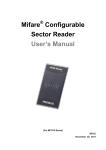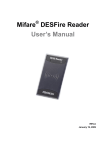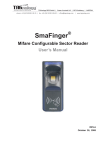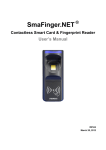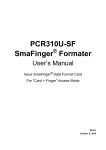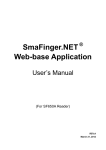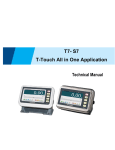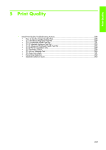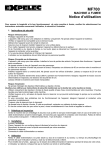Download LBR300 Mifare Configurable Sector Reader User's Manual
Transcript
LBR300 ® Mifare Configurable Sector Reader User’s Manual REV.A September 18, 2008 LBR300 PROMAG REV.A Mifare® Configurable Sector Reader Overview: LBR300 is a user configurable mifare® sector data reader. It can be configured to read mifare® card with MAD1/MAD2 standard in a mifare® application open system, or can be configured to read the user-defined sector data (Non-MAD) in a user defined closed system. Output interface can be configured as an RS232 output or Wiegand output. Wiegand output is selectable from 26 bits to 128 bits. LBR300 also can be set with a Reader ID number for multi-unit communication. Features: 1. Possible to be installed on metal surface 2. Supports MAD1/MAD2 standard and customer MAD-AID setting 3. Supports Non-MAD format with user-defined sector number. 4. Supports Multi Sectors 5. Reads Mifare® Standard 4K or Mifare® Standard 1K card 6. Sets Reader ID number for multi-link application 7. Three output interfaces: Wiegand (Default), RS232 and MSR ABA TK2 8. Wiegand output is selectable from 26 bits to 128 bits 9. RS232 output packet can be set with Header, Reader ID and trailer 10. Internal LED and buzzer are configurable 11. Weather resistant Application: 1. Access Control. 2. Time Attendance. 3. Guest Registration System. 4. Academic Services. 5. Info Services. 1 LBR300 PROMAG REV.A Mifare® Application Directory (MAD) Support: LBR300 support the MAD format card, the MAD (mifare® application directory) standard proposes the introduction of common data structures for card application directory entries. LBR300 reader should take advantage of this feature using those sector pointers instead of physical sector number. Auto Mode The LBR300 will search the AID from mifare® application directory (MAD) , then got a correct sector number from MAD. If the card is not a MAD card, the Request Anticollision LBR300 will use the Non-MAD Sector# (Setting by No Tag LBR300 Utility). About MAD please see the web pages: Card On Reader http://www.mifare.net Is MAD Card http://www.semiconductors.philips.com/ac No robat/other/identification/M001824.pdf Yes AID Match No Yes Get Using LBR300 Application Sector# Non-MAD Sector# APP KEY Authenticate NG PASS Read Sector Data Un-know Output Data 2 LBR300 PROMAG REV.A User-Data Format LBR300 will send out the data following the format as below, the user data length defined by the Data-Info. At wiegand output format, the data output length is fixed (defined by Number Of Bits), so the user data would be cut if longer than Number of Bits, or the user data would be appended with zero “0” if shorter than Number of Bits. Byte 0 Block 0 Application Block 1 Sector # Block 2 Byte 15 Data-Info USER DATA (Max 128 Bytes) Block 3 Data-Info bit7 bit6 bit5 Data Type (11b) bit0 Data Length Data Type is fixed with 11b which meets “any other data” type of “Card Holder information” as MAD standard. And data length is including the data with ending zero “0”, so the number of data byte sent by LBR300 is equal to data length with one less for RS232 output. Example: Data Length is 16, LBR300 only send out 15 bytes for RS232 output. 3 LBR300 PROMAG REV.A Wires Assignment Color Symbol I/O Description Red VCC IN Power Input : DC 7.5V~24V Black GND IN Power Ground White DATA 1 OUT Wiegand Data 1 Signal / ABA TK2 Clock (Strobe) Green DATA 0 OUT Wiegand Data 0 Signal / ABA TK2 Data Yellow TXD OUT RS232 TXD (To Host RXD) Blue RXD IN RS232 RXD (To Host TXD) Orange CP OUT ABA TK2 Card Present Brown LED/BUZEER IN External LED/BUZZER Control Connect To MF700KIT before configure the LBR300 Reader. To configure the LBR300 reader you need connect the reader to the MF700KIT first as below: MF700KIT ORANGE BLACK CP GND D1 D0 RX TX VCC WHITE RED WAS-T0029 YELLOW BLUE GREEN BROWN " " " " The above housing is for reference only 12VDC Remark: Brown wire is for External LED/Buzzer Control, and Blue wire is keep in RS232 RX signal for communication only. Note: MF700KIT is a test connection kit for LBR300 configuration use. It is an optional item for purchasing. 4 LBR300 PROMAG REV.A Mifare Reader Utility 1. Mifare Settings: MAD-AID: (Default=4703) MAD Application Identifier number is authorized and assigned by Mifare.net upon the customer’s request for registered Application Identifier in a mifare® application open system (AID: 0000h~FFFFh). Or it is also possible for the user to define the AID himself for the application in user defined closed system without registering into MAD group. According to the AID, LBR300 can find and read the corresponding sector on the MAD card. Non-MAD Sector: (Default =0) When the card is Non-MAD format, LBR300 will only read the “Non-MAD Sector”. (1K Card Sector: 0~15, 4K Card Sector:0~39). For the Non-MAD application, user can freely define the Sector. App Key (KEY_A): (Default=FFFFFFFFFFFF) App Key must be the same as the KEY_A of the card issued. This means LBR300 only can read the sector data on the card with the same KEY_A. Encrypt: (Default=None) Fraud prevention, Select Encrypt Mode (None, Encrypt 1, Encrypt 2, Encrypt 3, Encrypt 4, Encrypt 5) to protected your card data. (Remark: Encrypt mode must to work together with the same encrypt mode of “Mifare Card Issuer” software.) 5 LBR300 PROMAG REV.A Used Card (Not issued by “Mifare Card Issuer”) You have to indicate the data position in the card, when the card is not issued by “Mifare Card Issuer” software. And you must set the “Offset” (Max 255, and base from zero) form the beginning of sector and set your data “Length” (Max 128). Example: If your card data in the grey grid of sector, you have to set the “Offset” = 17, and set the “Length”= 20. AID Sector (or Non-MAD Sector) Block 0 0 1 2 3 4 5 6 7 8 9 10 11 12 13 14 15 Block 1 16 17 18 19 20 21 22 23 24 25 26 27 28 29 30 31 Block 2 32 33 34 35 36 37 38 39 40 41 42 43 44 45 46 47 6 LBR300 PROMAG REV.A 2. Reader Settings Reader ID : (Default=0) LBR300 Reader ID for multi link application. (ID: 0~99). Interface : (Default=Wiegand) LBR300 can be set as Wiegand , RS232 or ABA-TK2 output. Read Mode: (Default=Card Data Only) a. Card Data Only: Read card sector data only; If any error (ex. mifare key error), reader will show “Card Invalid” status. b. Card Data or CSN (Card Serial Number): Read card sector data, If any error (ex. mifare key error), reader will send the CSN to host. c. CSN Only: CSN read only. Output Mode: (Default=Once) a. Once: Send data (or CSN) to host once. b. Continue: Keeping sending data (or CSN) to host till card remove. 7 LBR300 PROMAG REV.A 3. LED / Buzzer Settings New LBR300 support the LED/Alarm Configuration. Setting the LED/Buzzer to indicate the system status for end-user. Enable RS232 Command Set Control: (For 19200,n,8,1 Only) RS232 LED/Buzzer command set frame as below: STX 02h J 4Ah NUMBER (0~9) 30h~39h CR 0Dh Command Table: NUMBER 0 (30h) 1 (31h) 2 (32h) 3 (33h) 4 (34h) 5 (35h) 6 (36h) 7 (37h) 8 (38h) 9 (39h) Descriptions All LED Off, Buzzer Off Green LED ON Green LED OFF Red LED ON Red LED OFF Buzzer Beep 1 Time Buzzer Beep 3 Time Green LED ON with Beep 1 Time Red LED ON with Beep 3 Time All LED ON (Orange) Remark: If Enable the RS232 Command Set Control (for LED/Buzzer), the external LED/Buzzer control with high/low level control will be disable. Read Idle: Show LED color after power on or idle state. Brown wire = PULSE (or Card is valid): Show LED color and beeps to indicate the end-user when brown wire = PULSE, or card was passed by LBR300 reader. 8 LBR300 PROMAG REV.A Brown wire = Inactive ( or Card Is invalid): Show LED color and beeps to indicate the end-user when brown wire = Inactive, or card was failed by LBR300 reader. Brown wire = Active: Show LED color and beeps to indicate the end-user that brown wire = Active signal from Host. Brown wire Active level: Set Brown wire Active level condition with Host status. Disable: Always disable the Brown wire. (Default), LED/Buzzer control by reader self. High: Active High / Normal keep in Low. Low: Active Low / Normal keep in High. Remark: If set Active Low, you may have to connect brown wire to a pull-up resistor (1K~10K) with 5VDC). Control Brown wire: After Data Output: The brown wire will be enabling after finished output the card data or CSN. (Default) Any Time: The brown wire enabled in any time. Note: See Annex E, the LED/Buzzer also can be controlled externally with High/Low level control. 9 LBR300 PROMAG REV.A 4. Wiegand Setting: Number of Bits is to set the Wiegand output type you want to meet your Host (or Terminal). It can be 26 to 128 (Default=26). Include Reader ID1 is to set the Wiegand output data to include Reader ID when it is enabled. (Default=Disable). Bit Sequence is to set the Wiegand output data sequence, it can be standard data sequence (MSB first) or Reverse data sequence (LSB first). (Default=Standard). with Parity is to set the Wiegand output data with Parity bits or not. (Default=Enable) 10 LBR300 PROMAG REV.A 5. ABA-TK2 Settings Number Of Digital: Set number of digital codes for TK2 output. (Default=10) Add Reader ID: Add Reader ID into TK2 data. (Default=Disable) Sequence: Set the TK2 data sequence. (Default=MSB First) Data Conversion: Select card data format to convert , a. BIN to DEC (Default, card issue by Mifare Card Issuer Utility) b. Decimal String (ex. “123456”) c. BCD d. Direct (Memory Map) e. Bytes to DEC 11 LBR300 PROMAG REV.A 6. RS232 Setting: Baudrate can be set 2400bps~57600bps (Default=19200bps) Data Sequence can be set “LSB” first (Default) and “MSB” first. Package2 is to set the output data packet to include Header, Reader ID, Data Length, CR, LF and Trailer. (Header:00h~FFh, Trailer : 00h~FFh). (Default = None included) Output Format can be “Binary” or “Hex String” for output format. Note: (1).Wiegand output data packet with Reader ID: Standard Parity(Even) Reader ID (MSB) Data Bits (LSB) Parity(Odd) Reverse Parity(Odd) Reader ID (LSB) Data Bits (MSB) Parity(Even) (2).RS232 output data packet with Header, Reader ID and Trailer: Header Reader ID (LSB) Data Bytes (MSB) Trailer (3).ABA-TK2 with Reader ID: MSB First SS Reader ID (MSB) Digital Code (LSB) ES LRC LSB First SS Reader ID (LSB) Digital Code (MSB) ES LRC Remark: LBR300 all configuration items are write only, so any users can not read the configuration items from LBR300 to get the App Key, that is very important to protect your App Key and all configuration items. 12 LBR300 PROMAG REV.A Test LBR300 Reader after configuration After LBR300 configuration is completed you may use Mifare Reader Utility “Test” function to test the LBR300 to see if the configuration is done correctly. 1. After the configuration on the Mifare Reader Utility software is made, you should click [Update Reader] to download the current configuration to the LBR300 Reader. 2. After LBR300 configuration is completed, you may click [Test] to test LBR300 Reader. 3. Get an issued mifare® card to put on LBR300 reader to be read and see the output data on the window of “Reader Test”. Wiegand 26 bits output data with standard bit sequence, example as below: 13 LBR300 PROMAG REV.A ANNEX A. Hardware Specification LBR300 Major Feature Mifare® Application Directory Reader Access Control & Security Power Requirements DC 7.5 ~ 24 Volts 3W Interface Wiegand 26 bits ~ 128bits Selectable RS232, MSR ABA -TK2 Card type Mifare MF1 standard cards for 1024 / 4096 bytes of memory Maximum reading distance Up to 50 mm with MFA01 card in ideal conditions Frequency 13.56 MHz standard Card format MAD1 / MAD2 Audio/Visual Indication Buzzer /LED lamp Dimensions W105 x D105 x H18mm Housing material ABS Environment Operating temperature 0 ~ +60 °C Storage temperature -10 ~ +70 °C Operating relative humidity 10 ~ 90% Note: 1. Mifare Class: Mifare Standard 1K/4K/Pro (without Mifare Ultra-Light). 2. LBR300 RF distance can reach up to 50mm with MFA01 (Mifare® Standard 1K Card) of GIGA-TMS INC. 14 LBR300 PROMAG REV.A ANNEX B. Wiegand Interface The Data 1 and Data 0 signals are held at a logic high level unit, the reader is ready to send a data stream. The reader places data as asynchronous low-going pulses on the Data 1 or Data 0 lines to transmit the data stream to Host. The Data 1 and Data 0 pulses will allowable pulse width times and pulse interval times for the LBR300 reader. Data 1 Signal Data 0 Signal ` Tpw Tpi Tpw Tpi Pulse Times Symbol Description Typical Time Tpw Pulse Width Time 100us +/- 3% Tpi Pulse Interval Time 1.9ms +/- 3% Wiegand Packet (Without Reader ID) Standard (Default) Parity(Even) (MSB) Data Bits (LSB) Parity(Odd) Reverse (Option) Parity(Odd) (LSB) Data Bits (MSB) Parity(Even) Connect the Wiegand wires, example as below: (The pull high resister must >= 10K Ohm) HOST/Terminal 5VDC Pull high resistor 9~24VDC LBR300 (Red) 10K 10K ohm ohm Data 1 (White) Data 0 (Green) (Black) GND GND Optional: External LED/Buzzer Control (Brown) 15 >=10K Ohm LBR300 PROMAG REV.A ANNEX C. ABA TK2 Interface The timing for Card Present, Clock (Strobe) and Data , example as below: /CARD PRESENT Leading Zero Data Trailing Zero /DATA /STROBE (CLOCK) 0 0 0 . . . 0 1 1 0 1 0 0 1 . . . 0 0 0 STROBE Width Approximately 25~50% Of Bit Time Bit Time 40IPS (min:280us, typ:330us, max:480us) DATA The data signal is valid while the clock is low. If the Data signal is high, the bit is a zero. If the Data signal is low, the bit is a one. CLOCK (STROBE) The Clock signal indicates when Data is valid. It is recommended that Data be loaded by the user with the leading edge (negative) of the Strobe. CARD PRESENT Card Present will go low after flux reversals from the Reader. Card Present will return high after the last flux reversal. Connect the ABA TK2 wires, example as below: HOST/Terminal 9~24VDC (Red) LBR300 Card Present (Orange) Clock (White) Data (Green) (Black) GND GND Optional: External LED/Buzzer Control (Brown) 16 LBR300 PROMAG REV.A ANNEX D. RS232 Interface Connect the RS232 wires, example as below: HOST/Terminal 9~24VDC (Red) LBR300 TXD (Yellow) GND (Black) GND GND Optional: External LED/Buzzer Control (Brown) 17 LBR300 PROMAG REV.A ANNEX E. External LED/Buzzer Control LBR300 supports the external LED/Buzzer control for Terminal (or Host) to prompt end-user the card data is invalid or valid. Use Brown wire to control the LED/Buzzer of LBR300 Examples as below: (Active High) (1) Show External Invalid Status Data Output Alarm Control (Brown) Min 100ms (2) Show Card Valid Status Data Output Alarm Control (Brown) Min 100ms Note: 1. Send one pulse to show the “Extern Invalid” LED/Buzzer Status. 2. Send three or more pulse to show the “Card Valid” LED/Buzzer status. 3. You can configure the LED/Buzzer status by Mifare Reader utility. 18 LBR300 PROMAG REV.A ANNEX F. Order Information Part Number Include Description LBR300-00 LBR300 LBR300 Configurable Reader LBR300SK-00 LBR300 LBR300 Configurable Reader (Start Kit) MF700KIT-10 Reader Kit for configuration MFA01(3PCS) Mifare® Standard 1K Card PCR310U Card Issue Programmer Power Adaptor(Option) DC Power Adaptor 9VDC MF700KIT Reader Kit WAS-T0029 RS232 Cable(D-Sub 9P Female to Male) DISK5238 Card Issue and Utility Software Power Adaptor(Option) DC Power Adaptor 9VDC PCR310U Card Issue Programmer DISK5238 Card Issue and Utility Software MFA01(3PCS) Mifare Standard 1K Card MFA01 MFA01 Mifare® Standard 1K Card MFA04 MFA04 Mifare® Standard 4K Card MF700KIT-10 PCR310U-CI 19 LBR300 PROMAG REV.A ANNEX G. WebISP - Firmware Upgrade Utility LBR300 also supports the ISP (In-System Program) function to upgrade the reader’s firmware. Install the WebISP (include in CD-ROM) in your Windows System first (It may need to reboot your system) and follow the steps as below: (First of all, you need to connect the reader or programmer to PC, and make sure they were power-on) Step 1: Input your account (UserName and Password) Note: Contact us to get your account when needed. Step 2: Click [Start Check] to automatically check the firmware version from our FTP server. Show the update Note: history. 1. The WebISP will auto scan all Comm ports to search the reader or programmer. 2. The WebISP will show the [Update Information] and list the update history. 20 LBR300 PROMAG REV.A Step 3: If your reader’s or programmer’s firmware out of date, then WebISP will prompt you to update the firmware. Click [Update] to begin Updating the firmware. Step 4: Wait for the updating to finish. And repeat step 2 to update other readers or programmers. Update finished 21 LBR300 PROMAG REV.A ANNEX H. Configured Card LBR300 supports updating the reader by reading Configured Card. Step 1: Only connect PCR310 to PC without any LBR300 Reader. Click "Auto Scan", then found the PCR310. Select the "MF700 Series" option and Click "OK". Step 2: Click "Configure Card" to using current settings to creating a "Configured Card". Step 3: Put a new Mifare Card on PCR310 and Click "Create" to Create the "Configured Card" 22 LBR300 PROMAG REV.A ANNEX G. History Rev A: September 18, 2008 Initial LBR300 Configurable Sector Reader. PROMAG ® GIGA-TMS INC. http://www.gigatms.com.tw mailto:promag@gigatms.com.tw TEL : +886-2-26954214 FAX : +886-2-26954213 Office: 8F, No. 31,Lane 169, Kang-Ning St.,Hsi-Chih, Taipei, Taiwan 23

























